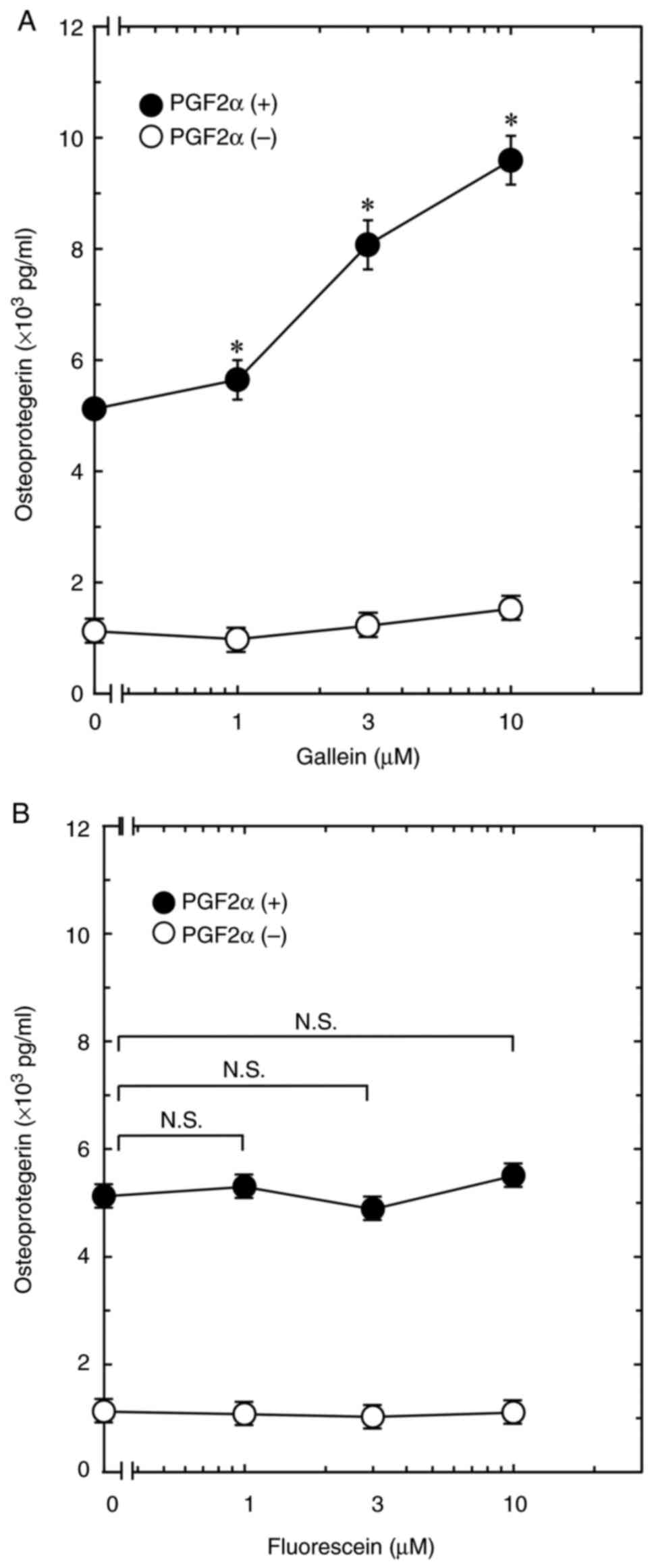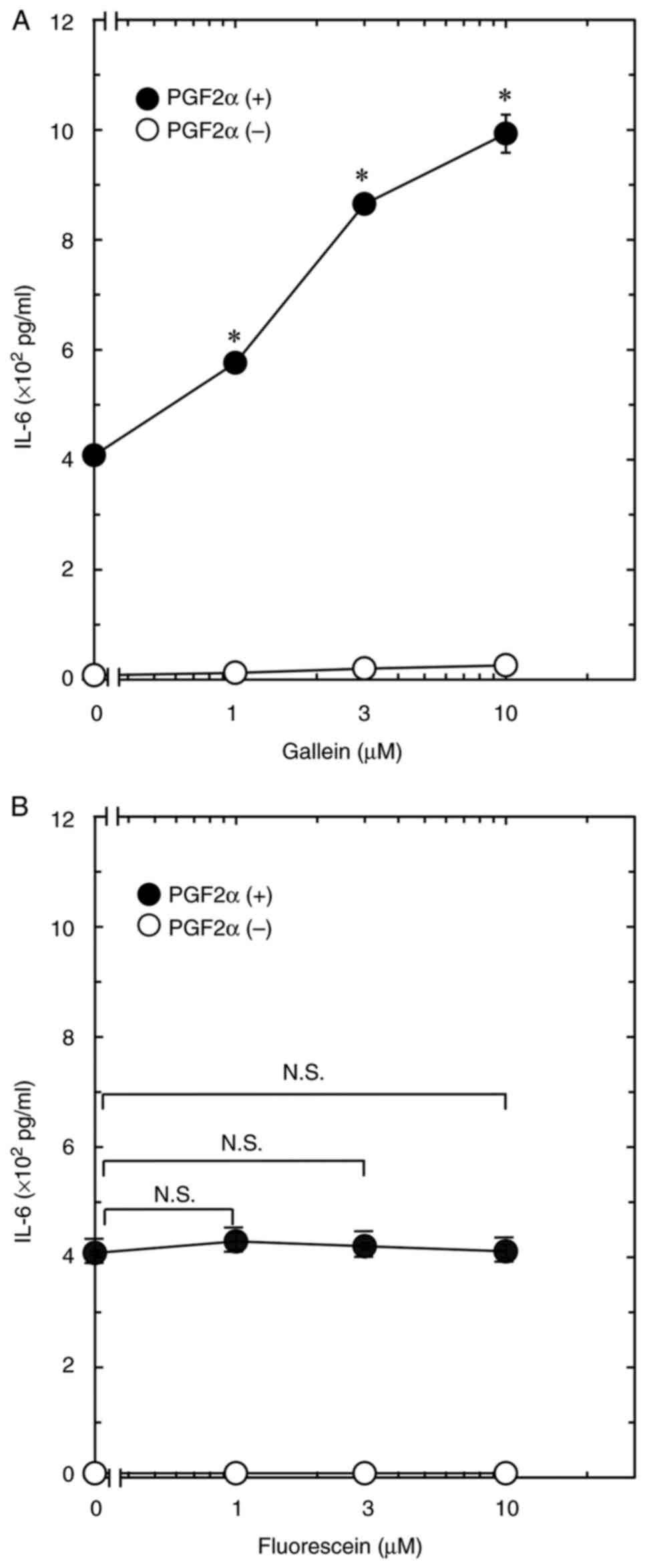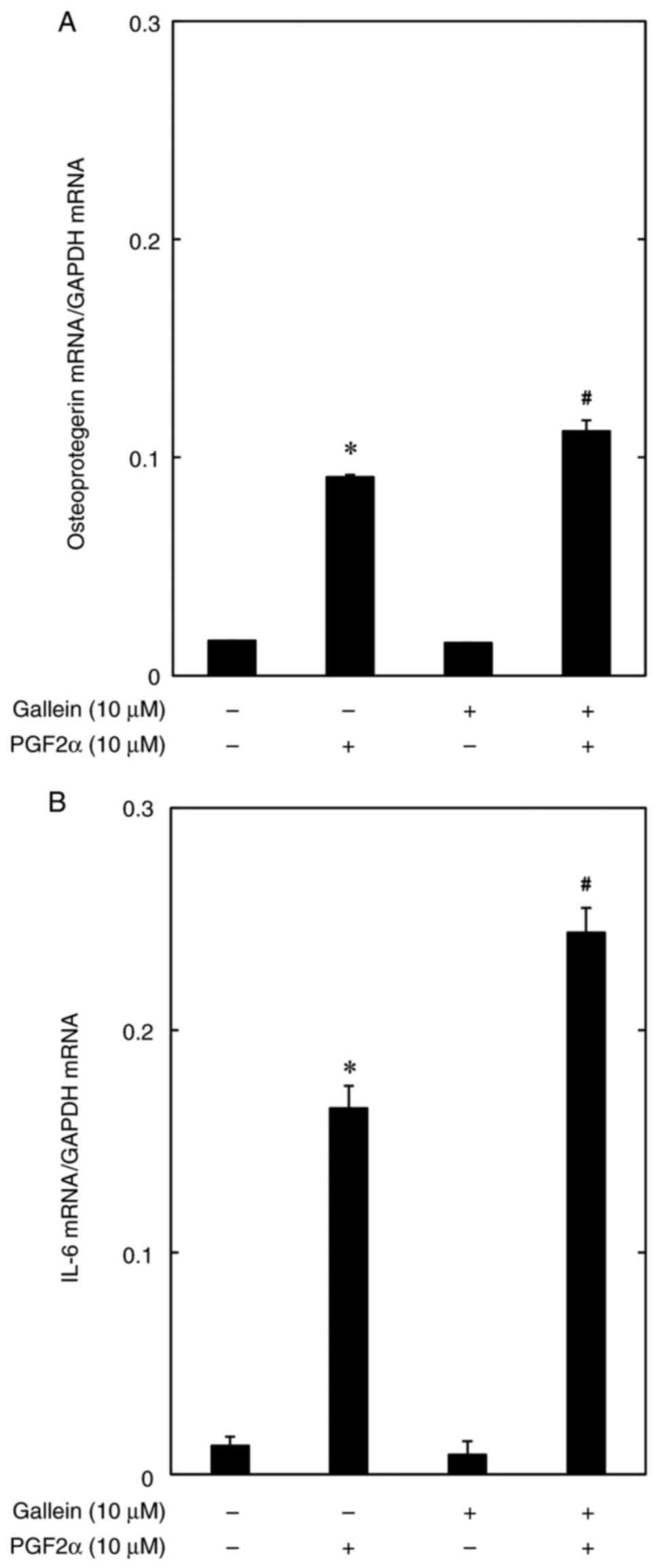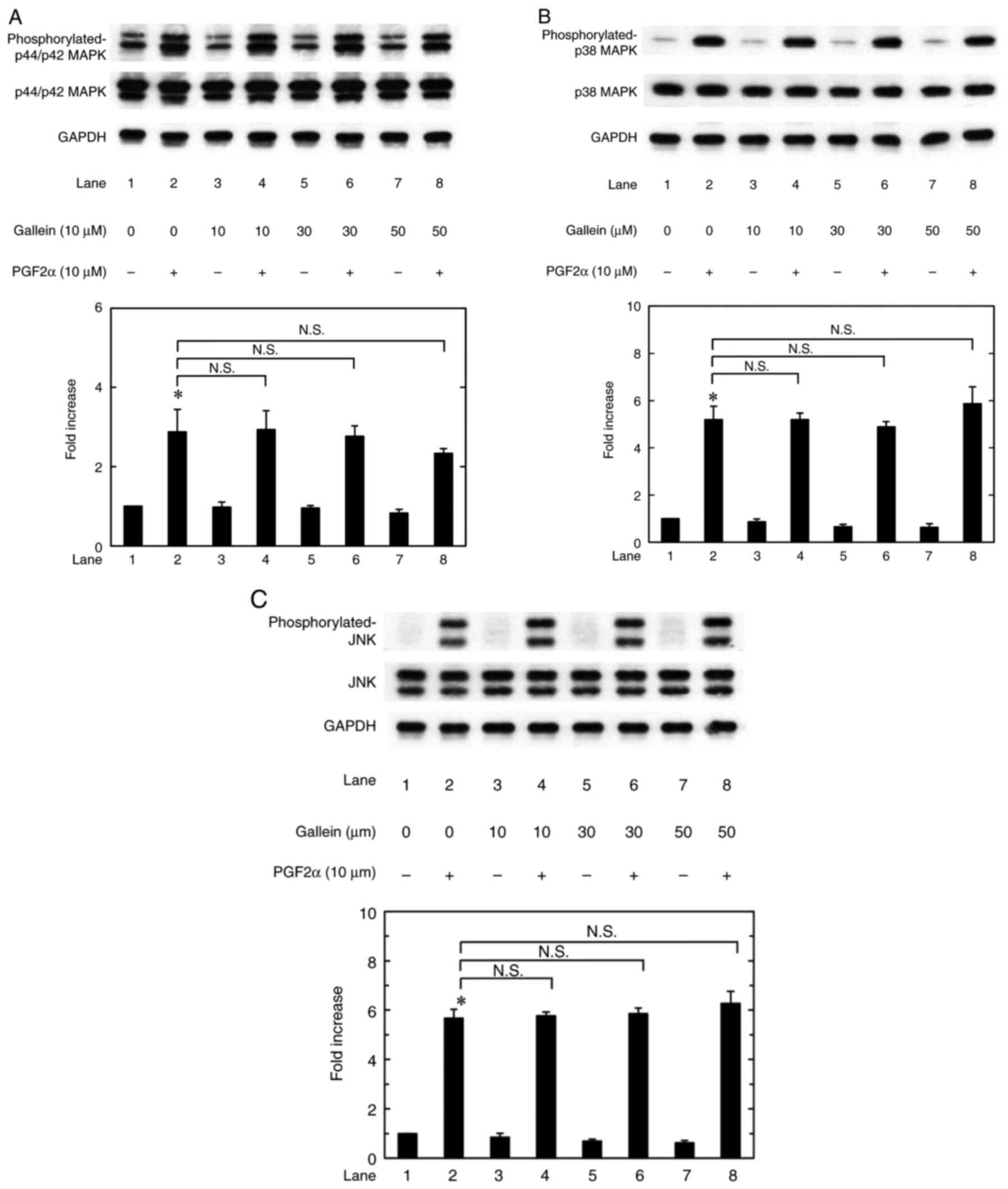Gallein increases prostaglandin F2α‑induced osteoprotegerin and IL‑6 secretion in osteoblasts
- Authors:
- Published online on: August 14, 2024 https://doi.org/10.3892/br.2024.1835
- Article Number: 147
Abstract
Introduction
Osteoclasts that first resorb calcified bone and osteoblasts that form new bone to maintain homeostasis retain the bone mass. The processes to maintain adequate bone mass are known as bone remodeling. Disrupted bone remodeling, such as bone formation and resorption dysregulation, causes metabolic bone diseases such as osteoporosis (1). Osteoblasts secrete osteoprotegerin (OPG) which is a member of the TNF receptor family, along with receptor activator of NF-κB (RANK) (2). OPG binds to the RANK ligand (RANKL) on osteoblasts as a decoy receptor, prevents RANKL-RANK binding on osteoclasts, and inhibits osteoclast formation and bone resorption (2). IL-6, a pro-inflammatory cytokine, is a bone resorption factor as it promotes osteoclast development (3). The role of IL-6 in mouse osteoblasts is to promote the differentiation of embryonic fibroblasts into osteoblasts and induce mineralization (4), whereas another study reveals that IL-6 suppresses bone formation in mouse osteoblastic MC3T3-E1 cells and primary mouse osteoblasts (5). Therefore, OPG and IL-6 generally serve an important role in bone remodeling that involves both osteoblasts and osteoclasts.
Prostaglandin F2α (PGF2α) serves different roles in bone metabolism by regulating intracellular signal transduction pathways within osteoblasts (6). PGF2α has traditionally been seen as a dominant bone resorbing agent, but it is now recognized as a bone remodeling regulator (7). Our previous studies revealed that PGF2α increases IL-6 secretion through p44/p42 MAPK and p38 MAPK pathways in the osteoblast-like MC3T3-E1 cell line (8,9). In addition, PGF2α increases OPG synthesis via p44/p42 and p38 MAPKs and stress-activated protein kinase/JNK pathways in the MC3T3-E1 cell line (10). Therefore, PGF2α-induced cellular responses in osteoblasts involves activating three major MAP kinases, including p44/p42 and p38 MAPKs and JNK.
Gallein is a Gβγ subunit and G protein (Gs) signaling inhibitor (11). Gallein has been found in mouse in vivo studies to inhibit Gs signaling, suppressing progression of heart failure progression (12). In addition, gallein blocks the chemotaxis of human promyelocytic leukemia cells and primary human neutrophils. Systemic gallein administration inhibits paw edema and neutrophil infiltration in a carrageenan-induced mouse paw edema model, indicating that targeting Gβγ regulation may be an effective anti-inflammatory strategy (13). Therefore, regulating OPG and IL-6 may improve our understanding of the benefits of gallein on bone health, but the association of gallein with OPG and IL-6 synthesis in osteoblasts and the molecular mechanisms behind it remains to be elucidated. The present study aimed to investigate the role of gallein in PGF2α-induced OPG and IL-6 secretion as well as the mechanism in vitro in osteoblasts.
Materials and methods
Materials
Calbiochem (Merck KGaA) and MilliporeSigma provided gallein and fluorescein, respectively. R&D Systems, Inc. supplied PGF2α and mouse OPG (cat. no. MOP00) and IL-6 (cat. no. M6000B) ELISA kits. Cell Signaling Technology, Inc. provided antibodies, including phosphorylated (p-)p44/p42 MAPK (cat. no. 9101), p44/p42 MAPK (cat. no. 9102), p-p38 MAPK (cat. no. 4511), p38 MAPK (cat. no. 9212), p-JNK (cat. no. 4668), and JNK (cat. no. 9252). Santa Cruz Biotechnology, Inc. supplied glyceraldehyde-3-phosphate dehydrogenase (GAPDH) antibodies (cat. no. sc-25778). Peroxidase-labeled anti-rabbit IgG antibodies (cat. no. 5220-0336; SeraCare Life Sciences, Inc.) and peroxidase-labeled anti-mouse IgG antibodies (cat. no. 7076; Cell Signaling Technology, Inc.) were used as secondary antibodies. Cytiva provided an ECL western blotting detection system.
Cell culture
The osteoblast-like MC3T3-E1 cells are naturally immortalized and calvaria-derived cell lines (14). Dr M Kumegawa (Department of Dentistry, Graduate School of Dentistry, Meikai University, Sakado, Japan) donated these cells. Cells were maintained in minimal essential medium (α-MEM; MilliporeSigma) supplemented with 10% fetal bovine serum (FBS; Thermo Fisher Scientific Inc. and incubated at 37˚C and 5% CO2 (15). Cells were plated on 90-mm diameter plates (2x105 cells/plate) and 35-mm diameter plates (5x104 cells/plate) in α-MEM supplemented with 10% FBS. The incubation medium was replaced with α-MEM supplemented with 0.3% FBS 5 days after seeding. Cells were used for experiments after 48 h.
Measurement of OPG and IL-6
Cultured cells were treated with 10 mM of PGF2α or vehicle in 1 ml of α-MEM supplemented with 0.3% FBS for 48 h at 37˚C. These cells were pretreated with 1, 3, and 10 µM gallein or fluorescein for 60 min. The conditioned medium was collected at the end of the incubation, and the OPG and IL-6 concentrations in the medium were measured by mouse OPG and IL-6 ELISA kits following the manufacturer's protocol (16).
Reverse transcription-quantitative (RT-q) PCR
Equal counts of cells (5x104 cells/35-mm dish) were seeded and cultured through identical process among all the experiments and used for the experiments 1 week after seeding. Cultured cells were pretreated with 10 µM of gallein for 60 min and then stimulated with 10 µM of PGF2α in α-MEM supplemented with 0.3% FBS for 3 h. TRIzol reagent (Thermo Fisher Scientific, Inc.) was used to isolate total RNA that was reverse transcribed into cDNA using the Omniscript Reverse Transcriptase kit (Qiagen, Inc.). A Light Cycler system with Fast Start DNA Master SYBR Green I (Roche Diagnostics) was used for RT-qPCR. RNA extraction, cDNA synthesis, and qPCR performed according to the manufacturer's protocols. Samples were subjected to the following PCR thermocycling conditions: Initial denaturation at 95˚C for 10 min, followed by 40 cycles of denaturation at 95˚C for 1 sec, annealing at 60˚C for 5 sec and elongation at 72˚C for 7 sec. Predesigned primer sets for mouse OPG (cat. no. MA026526) and IL-6 (cat. no. MA039013) were obtained from Perfect Real-Time Supporting System (Takara Bio Inc.). For the GAPDH primer, the GAPDH sequence from a previous article was adopted (16) and MilliporeSigma synthesized the GAPDH primer (Forward primer ID: 5852-065, Reverse primer ID: 5852-066) with the same sequence. The primer sequences were as follows: OPG forward, 5'-CAATGGCTGGCTTGGTTTCATAG-3' and reverse, 5'-CTGAACCAGACATGACAGCTGGA-3'; IL-6 forward, 5'-CCACTTCACAAGTCGGAGGCTTA-3' and reverse, 5'-GCAAGTGCATCATCGTTGTTCATAC-3'; and GAPDH forward, 5'-AACGACCCCTTCATTGAC-3' and reverse, 5'-TCCACGACATACTCAGCAC-3'. All measurements were analyzed using the 2-ΔΔCq method (17). All experiments were performed and analyzed in triplicate.
Western blot analysis
Cultured cells were preincubated with 10, 30, and 50 µM of gallein and stimulated with 10 µM of PGF2α in α-MEM containing 0.3% FBS for the indicated periods. Cells were rinsed with phosphate-buffered saline and lysed with lysis buffer that contained 62.5 mM of Tris/HCl, 50 mM of dithiothreitol, 2% sodium dodecyl sulfate (SDS), and 10% glycerol for western blot analysis. Proteins were separated on a 10% sodium dodecyl sulfate-polyacrylamide gel electrophoresis gel and transferred to a polyvinylidene difluoride (PVDF) membrane, followed by western blot analysis (18). Although the mass of protein per lane was not quantified, the same number of cells (2x105 cells/dish) was seeded in each dish. The days of treatment, conditions, and lysis buffer dose were also the same for each dish. Lysates (10 µl) were applied per lane of all SDS-PAGE gels. The membranes were blocked with 5% fat-free dry milk in Tris-buffered saline-Tween (TBS-T; 20 mM Tris-HCl, pH7.6, 137 mM NaCl, 0.1% Tween20) at room temperature for 2 h before incubation with primary antibodies. The membrane was then incubated with primary antibodies (1:1,000) against p38 MAPK, p-p38 MAPK, p44/p42 MAPK, p-p44/p42 MAPK, JNK, p-JNK and GAPDH in 5% fat-free dry milk-TBS-T at 4˚C overnight. The membrane was incubated with secondary antibodies (1:1,000) in 5% fat-free dry milk-TBS-T at room temperature for 1 h. The same cell lysate was used for phosphorylation, total, and GAPDH in the present study. The peroxidase activity on the PVDF sheet was visualized on X-ray film using the ECL western blotting detection reagents (cat. no. RPN2109, Cytiva).
Densitometric analysis
A scanner and image analysis software (ImageJ version 1.48; National Institutes of Health) was used for densitometric analysis of western blots. Phosphorylated protein levels were calculated as follows: The background-subtracted signal intensity of each phosphorylation signal was normalized to the respective intensity of total protein and plotted as a fold increase compared to unstimulated control cells.
Statistical analysis
Mini StatMate (version 2.01; ATMS) was used for all data analysis. Analysis of variance followed by the Bonferroni significance test was used for multiple comparisons between the two groups. All measurements were conducted and analyzed in triplicate from dependent cell preparations. Data were expressed as mean ± standard deviation. P<0.05 was considered to indicate a statistically significant difference.
Results
Gallein, but not fluorescein, increases PGF2α-induced OPG release using the MC3T3-E1 cell line
The present study first investigated the effect of gallein on PGF2α-induced OPG secretion using an osteoblastic MC3T3-E1 cell line. The result revealed that gallein did not affect OPG release in MC3T3-E1 cells, but significantly increased PGF2α-induced OPG secretion. The effect of gallein on OPG secretion increased dose-dependently up to 10 µM (Fig. 1A). The association of fluorescein, a gallein-like compound that does not bind Gβγ (13), with PGF2α-induced OPG secretion was also investigated. The result indicated that fluorescein at concentrations of 1-10 µM demonstrated no effect on OPG secretion with or without PGF2α stimulation (Fig. 1B).
Gallein, but not fluorescein, increases PGF2α-induced IL-6 release using MC3T3-E1 cell line
The present study next investigated the effect of gallein on PGF2α-induced IL-6 secretion using the osteoblastic MC3T3-E1 cell line. The result revealed that gallein did not affect IL-6 release in the MC3T3-E1 cell line, but it significantly increased PGF2α-induced IL-6 secretion. The effect of gallein on IL-6 secretion increased dose-dependently at 1, 3, and 10 µM (Fig. 2A). In addition, the association of fluorescein with PGF2α-induced IL-6 secretion was investigated. The result revealed that 1, 3, and 10 µM of fluorescein did not affect IL-6 secretion with or without PGF2α stimulation (Fig. 2B).
Gallein enhances PGF2α-induced OPG and IL-6 mRNA expression using MC3T3-E1 cell line
The aforementioned results reveal that gallein improves OPG and IL-6 protein secretion; thus, the association of gallein with PGF2α-induced OPG and IL-6 mRNA expression levels was then investigated using the MC3T3-E1 cell line. The results revealed that 10 µM of gallein significantly improved PGF2α-induced OPG and IL-6 mRNA expression levels (Fig. 3).
Gallein does not affect PGF2α-activated p44/p42 MAPK, p38 MAPK and JNK in the MC3T3-E1 cell line
Regarding the signaling mechanism in osteoblasts, the authors previously used osteoblast-like MC3T3-E1 cells to demonstrate that PGF2α activates the phosphorylation of three major MAPKs, including p44/p42 and p38 MAPKs and JNK (10). The present study investigated how gallein affected p44/p42 and p38 MAPKs and JNK phosphorylation in these cells with or without PGF2α stimulation. The result was that gallein alone at 10, 30, and 50 µM did not affect p44/p42 and p38 MAPKs and JNK phosphorylation as well as PGF2α-activated p44/p42 and p38 MAPKs and JNK phosphorylation (Fig. 4).
Discussion
The present study revealed that gallein increased PGF2α-induced OPG and IL-6 secretion in osteoblast-like MC3T3-E1 cells. In addition, gallein improved the mRNA expression levels of PGF2α-induced OPG and IL-6. Therefore, gallein probably upregulated PGF2α-induced OPG and IL-6 secretion and the improving effect of gallein on PGF2α-induced OPG and IL-6 secretion may be mediated through transcriptional events. We have previously shown that PGF2α activates the phosphorylation of three major MAPKs, such as p44/p42 and p38 MAPKs and JNK, in osteoblast-like MC3T3-E1 cells regarding intracellular signal transduction by PGF2α in osteoblasts (10). In addition, we revealed that PGF2α increases OPG secretion by activating these three major MAPKs (10). In addition, PGF2α induces IL-6 secretion by activating p44/p42 and p38 MAPKs in these cells (8,9). The present study showed that gallein did not affect PGF2α-induced p44/p42 and p38 MAPKs and JNK phosphorylation. Therefore, the intracellular signaling pathway may not activate the three major MAPKs although gallein amplifies PGF2α-induced OPG and IL-6 secretion in osteoblast-like MC3T3-E1 cells. To the best of the authors' knowledge, this is the first study revealing the active involvement of gallein in PGF2α-induced OPG and IL-6 secretion in osteoblasts.
Heterotrimeric G proteins are membrane-bound G proteins that form heterotrimeric complexes. The heterotrimeric protein directly binds to seven transmembrane G protein-coupled receptors. Heterotrimeric proteins are composed of Gα, Gβ, and Gγ subunits. The subunit binds either GTP or GDP and acts as an on/off switch for G protein activation. A ligand that binds to a GPCR catalyzes the exchange of GDP and GTP on the Gα subunit and is released from the Gβγ subunit. Gα and Gβγ subunit dissociation enables each subunit to bind directly to downstream signaling proteins (19). Gallein generally inhibits Gβγ signaling without affecting GPCR-dependent Gα activation (20). The present study used fluorescein, which has a structure similar to gallein but does not bind to Gβγ (13), as a control to investigate the association of Gβγ inhibition with the effects of gallein. Fluorescein did not affect PGF2α-induced OPG and IL-6 secretion in osteoblast-like MC3T3-E1 cells at either the protein or mRNA levels. Therefore, fluorescein did not inhibit Gβγ signaling and was not involved in PGF2α-induced OPG and IL-6 secretion despite being a gallein-like compound. Therefore, the amplifying effect of gallein on PGF2α-induced OPG and IL-6 secretion is mediated by its Gβγ inhibition in osteoblasts.
PGF2α regulates various physiological functions by interacting with and activating the PGF2α receptor (FP), which belongs to the G protein-coupled receptor family. Generally, PG receptors activate different G protein subtypes, among which FP is primarily coupled to the Gα subunit. Gαβγ subunits dissociate into Gα and Gβγ components and cell signaling pathways are exerted when PGF2α binds to FP (21). Therefore, the present results indicated that gallein may act on FP, which has a GPCR structure, and inhibit the Gβγ subunit activation, thereby increasing PGF2α-induced OPG and IL-6 secretion in osteoblasts.
OPG binds to RANKL and inhibits RANK activation in bone metabolism, thereby preventing bone resorption through osteoclast differentiation and activation (2). The present study revealed that gallein upregulates PGF2α-induced OPG secretion in osteoblasts. Therefore, the positive result that gallein increases OPG secretion may indicate that gallein suppresses bone resorption by osteoclasts by regulating the RANK/RANKL/OPG axis. Conversely, the pro-inflammatory cytokine, IL-6, is generally a bone resorption factor. IL-6 can stimulate osteoclast formation in bone resorption in conditions such as estrogen deficiency (3). However, IL-6 exhibits a positive effect on bone formation and is considered an osteotropic factor (22). Furthermore, osteoclast bone resorption, followed by bone formation by osteoblasts, triggers bone resorption in bone remodeling (1). PGF2α generally serves an important role as a bone remodeling regulator (7). Considering these results, the findings that gallein enhances IL-6 are not necessarily inconsistent with the result that gallein promotes OPG. We have recently revealed that oncostatin M, which serves an important role in fracture healing, promotes PGD2-induced OPG and IL-6 secretion using the osteoblastic MC3T3-E1 cell line (23). The amplifying effect of gallein on OPG and IL-6 secretion may be an important discovery from the perspective of the treatment of metabolic bone diseases, considering that oncostatin M has favorable effects on bone metabolism.
In conclusion, the results of the present study revealed that gallein increased PGF2α-induced OPG and IL-6 secretion in osteoblasts, indicating that gallein may regulate bone remodeling through OPG/IL-6 in bone metabolism.
Acknowledgements
The authors thank Ms. Yumiko Kurokawa, Department of Pharmacology, Gifu University, for her skillful technical assistance.
Funding
Funding: The present study was supported by Grants-in-Aid for Scientific Research from the Ministry of Education, Culture, Sports, Science, and Technology (grant nos. 22K09438 and 19K18471) and from the National Center for Geriatrics and Gerontology, Japan (grant no. 20-12, 21-1).
Availability of data and materials
The data generated in the present study may be requested from the corresponding author.
Authors' contributions
GK was responsible for data curation, formal analysis, funding acquisition, writing-original draft, and approval of final manuscript. TH, RM-N and TO were responsible for data curation, formal analysis, writing the original draft and approval of final manuscript. OK was responsible for conceptualization, project administration, supervision, writing, reviewing and editing, and approval of final manuscript. HT was responsible for conceptualization, funding acquisition, project administration, supervision, writing, reviewing and editing, and approval of final manuscript. GK and HT confirm the authenticity of all the raw data. All authors read and approved the final manuscript.
Ethics approval and consent to participate
Not applicable.
Patient consent for publication
Not applicable.
Competing interests
The authors declare that they have no competing interests.
References
|
Kular J, Tickner J, Chim SM and Xu J: An overview of the regulation of bone remodelling at the cellular level. Clin Biochem. 45:863–873. 2012.PubMed/NCBI View Article : Google Scholar | |
|
Ono T, Hayashi M, Sasaki F and Nakashima T: RANKL biology: Bone metabolism, the immune system, and beyond. Inflamm Regen. 40(2)2020.PubMed/NCBI View Article : Google Scholar | |
|
Jilka RL, Hangoc G, Girasole G, Passeri G, Williams DC, Abrams JS, Boyce B, Broxmeyer H and Manolagas SC: Increased osteoclast development after estrogen loss: Mediation by interleukin-6. Science. 257:88–91. 1992.PubMed/NCBI View Article : Google Scholar | |
|
Taguchi Y, Yamamoto M, Yamate T, Lin SC, Mocharla H, DeTogni P, Nakayama N, Boyce BF, Abe E and Manolagas SC: Interleukin-6-type cytokines stimulate mesenchymal progenitor differentiation toward the osteoblastic lineage. Proc Assoc Am Physicians. 110:559–574. 1998.PubMed/NCBI | |
|
Kaneshiro S, Ebina K, Shi K, Higuchi C, Hirao M, Okamoto M, Koizumi K, Morimoto T, Yoshikawa H and Hashimoto J: IL-6 negatively regulates osteoblast differentiation through the SHP2/MEK2 and SHP2/Akt2 pathways in vitro. J Bone Miner Metab. 32:378–392. 2014.PubMed/NCBI View Article : Google Scholar | |
|
Hikiji H, Takato T, Shimizu T and Ishii S: The roles of prostanoids, leukotrienes, and platelet-activating factor in bone metabolism and disease. Prog Lipid Res. 47:107–392. 2008.PubMed/NCBI View Article : Google Scholar | |
|
Agas D, Marchetti L, Hurley MM and Sabbieti MG: Prostaglandin F2α: A bone remodeling mediator. J Cell Physiol. 228:25–29. 2013.PubMed/NCBI View Article : Google Scholar | |
|
Tokuda H, Kozawa O, Harada A and Uematsu T: p42/p44 mitogen-activated protein kinase activation is involved in prostaglandin F2α-induced interleukin-6 synthesis in osteoblasts. Cell Signal. 11:325–330. 1999.PubMed/NCBI View Article : Google Scholar | |
|
Minamitani C, Otsuka T, Takai S, Matsushima-Nishiwaki R, Adachi S, Hanai Y, Mizutani J, Tokuda H and Kozawa O: Involvement of Rho-kinase in prostaglandin F2α-stimulated interleukin-6 synthesis via p38 mitogen-activated protein kinase in osteoblasts. Mol Cell Endocrinol. 291:27–32. 2008.PubMed/NCBI View Article : Google Scholar | |
|
Kuroyanagi G, Tokuda H, Matsushima-Nishiwaki R, Kondo A, Mizutani J, Kozawa O and Otsuka T: Resveratrol suppresses prostaglandin F2α-induced osteoprotegerin synthesis in osteoblasts: Inhibition of the MAP kinase signaling. Arch Biochem Biophys. 542:39–45. 2014.PubMed/NCBI View Article : Google Scholar | |
|
Campbell AP and Smrcka AV: Targeting G protein-coupled receptor signalling by blocking G proteins. Nat Rev Drug Discov. 17:789–803. 2018.PubMed/NCBI View Article : Google Scholar | |
|
Casey LM, Pistner AR, Belmonte SL, Migdalovich D, Stolpnik O, Nwakanma FE, Vorobiof G, Dunaevsky O, Matavel A, Lopes CM, et al: Small molecule disruption of G beta gamma signaling inhibits the progression of heart failure. Circ Res. 107:532–539. 2010.PubMed/NCBI View Article : Google Scholar | |
|
Lehmann DM, Seneviratne AM and Smrcka AV: Small molecule disruption of G protein beta gamma subunit signaling inhibits neutrophil chemotaxis and inflammation. Mol Pharmacol. 73:410–418. 2008.PubMed/NCBI View Article : Google Scholar | |
|
Sudo H, Kodama HA, Amagai Y, Yamamoto S and Kasai S: In vitro differentiation and calcification in a new clonal osteogenic cell line derived from newborn mouse calvaria. J Cell Biol. 96:191–198. 1983.PubMed/NCBI View Article : Google Scholar | |
|
Kozawa O, Suzuki A, Tokuda H and Uematsu T: Prostaglandin F2α stimulates interleukin-6 synthesis via activation of PKC in osteoblast-like cells. Am J Physiol. 272:E208–E211. 1997.PubMed/NCBI View Article : Google Scholar | |
|
Simpson DA, Feeney S, Boyle C and Stitt AW: Retinal VEGF mRNA measured by SYBR green I fluorescence: A versatile approach to quantitative PCR. Mol Vis. 6:178–183. 2000.PubMed/NCBI | |
|
Livak KJ and Schmittgen TD: Analysis of relative gene expression data using real-time quantitative PCR and the 2(-Delta Delta C(T)) Method. Methods. 25:402–408. 2001.PubMed/NCBI View Article : Google Scholar | |
|
Laemmli UK: Cleavage of structural proteins during the assembly of the head of bacteriophage T4. Nature. 227:680–685. 1970.PubMed/NCBI View Article : Google Scholar | |
|
Hurowitz EH, Melnyk JM, Chen YJ, Kouros-Mehr H, Simon MI and Shizuya H: Genomic characterization of the human heterotrimeric G protein alpha, beta, and gamma subunit genes. DNA Res. 7:111–120. 2000.PubMed/NCBI View Article : Google Scholar | |
|
Koch WJ, Hawes BE, Inglese J, Luttrell LM and Lefkowitz RJ: Cellular expression of the carboxyl terminus of a G protein-coupled receptor kinase attenuates G beta gamma-mediated signaling. J Biol Chem. 269:6193–6197. 1994.PubMed/NCBI | |
|
Lv X, Gao K, Nie J, Zhang X, Zhang S, Ren Y, Sun X, Li Q, Huang J, Liu L, et al: Structures of human prostaglandin F2α receptor reveal the mechanism of ligand and G protein selectivity. Nat Commun. 14(8136)2023.PubMed/NCBI View Article : Google Scholar | |
|
Franchimont N, Wertz S and Malaise M: Interleukin-6: An osteotropic factor influencing bone formation? Bone. 37:601–606. 2005.PubMed/NCBI View Article : Google Scholar | |
|
Kuroyanagi G, Hioki T, Tachi J, Matsushima-Nishiwaki R, Iida H, Kozawa O and Tokuda H: Oncostatin M stimulates prostaglandin D2-induced osteoprotegerin and interleukin-6 synthesis in osteoblasts. Prostaglandins Leukot Essent Fatty Acids. 192(102575)2023.PubMed/NCBI View Article : Google Scholar |














